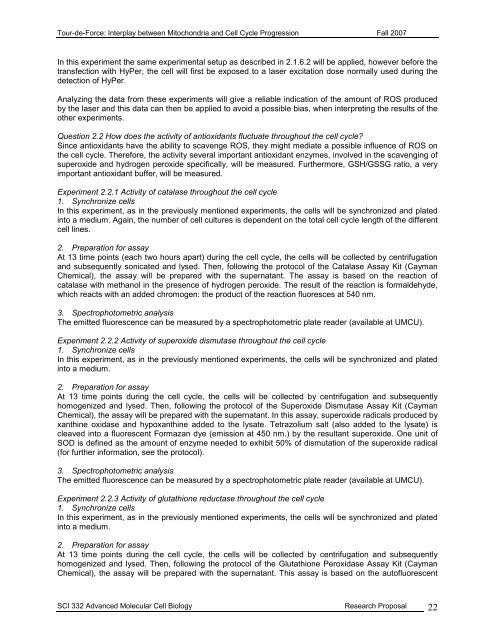Tour-de-Force
Tour-de-Force
Tour-de-Force
You also want an ePaper? Increase the reach of your titles
YUMPU automatically turns print PDFs into web optimized ePapers that Google loves.
<strong>Tour</strong>-<strong>de</strong>-<strong>Force</strong>: Interplay between Mitochondria and Cell Cycle Progression Fall 2007In this experiment the same experimental setup as <strong>de</strong>scribed in 2.1.6.2 will be applied, however before thetransfection with HyPer, the cell will first be exposed to a laser excitation dose normally used during the<strong>de</strong>tection of HyPer.Analyzing the data from these experiments will give a reliable indication of the amount of ROS producedby the laser and this data can then be applied to avoid a possible bias, when interpreting the results of theother experiments.Question 2.2 How does the activity of antioxidants fluctuate throughout the cell cycle?Since antioxidants have the ability to scavenge ROS, they might mediate a possible influence of ROS onthe cell cycle. Therefore, the activity several important antioxidant enzymes, involved in the scavenging ofsuperoxi<strong>de</strong> and hydrogen peroxi<strong>de</strong> specifically, will be measured. Furthermore, GSH/GSSG ratio, a veryimportant antioxidant buffer, will be measured.Experiment 2.2.1 Activity of catalase throughout the cell cycle1. Synchronize cellsIn this experiment, as in the previously mentioned experiments, the cells will be synchronized and platedinto a medium. Again, the number of cell cultures is <strong>de</strong>pen<strong>de</strong>nt on the total cell cycle length of the differentcell lines.2. Preparation for assayAt 13 time points (each two hours apart) during the cell cycle, the cells will be collected by centrifugationand subsequently sonicated and lysed. Then, following the protocol of the Catalase Assay Kit (CaymanChemical), the assay will be prepared with the supernatant. The assay is based on the reaction ofcatalase with methanol in the presence of hydrogen peroxi<strong>de</strong>. The result of the reaction is formal<strong>de</strong>hy<strong>de</strong>,which reacts with an ad<strong>de</strong>d chromogen: the product of the reaction fluoresces at 540 nm.3. Spectrophotometric analysisThe emitted fluorescence can be measured by a spectrophotometric plate rea<strong>de</strong>r (available at UMCU).Experiment 2.2.2 Activity of superoxi<strong>de</strong> dismutase throughout the cell cycle1. Synchronize cellsIn this experiment, as in the previously mentioned experiments, the cells will be synchronized and platedinto a medium.2. Preparation for assayAt 13 time points during the cell cycle, the cells will be collected by centrifugation and subsequentlyhomogenized and lysed. Then, following the protocol of the Superoxi<strong>de</strong> Dismutase Assay Kit (CaymanChemical), the assay will be prepared with the supernatant. In this assay, superoxi<strong>de</strong> radicals produced byxanthine oxidase and hypoxanthine ad<strong>de</strong>d to the lysate. Tetrazolium salt (also ad<strong>de</strong>d to the lysate) iscleaved into a fluorescent Formazan dye (emission at 450 nm.) by the resultant superoxi<strong>de</strong>. One unit ofSOD is <strong>de</strong>fined as the amount of enzyme nee<strong>de</strong>d to exhibit 50% of dismutation of the superoxi<strong>de</strong> radical(for further information, see the protocol).3. Spectrophotometric analysisThe emitted fluorescence can be measured by a spectrophotometric plate rea<strong>de</strong>r (available at UMCU).Experiment 2.2.3 Activity of glutathione reductase throughout the cell cycle1. Synchronize cellsIn this experiment, as in the previously mentioned experiments, the cells will be synchronized and platedinto a medium.2. Preparation for assayAt 13 time points during the cell cycle, the cells will be collected by centrifugation and subsequentlyhomogenized and lysed. Then, following the protocol of the Glutathione Peroxidase Assay Kit (CaymanChemical), the assay will be prepared with the supernatant. This assay is based on the autofluorescentSCI 332 Advanced Molecular Cell Biology Research Proposal 22
















